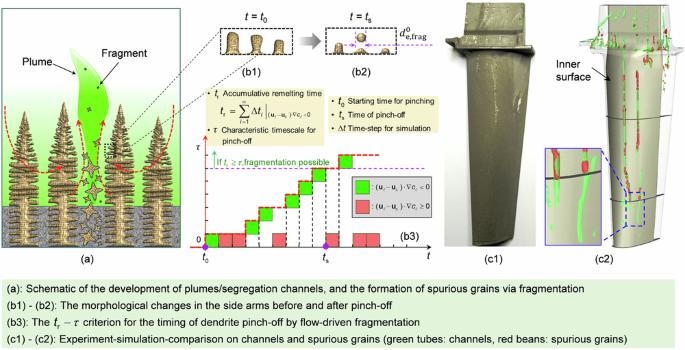Modelling freckles and spurious grain formation in directionally solidified superalloy castings
IF 9.6
Q1 MATERIALS SCIENCE, MULTIDISCIPLINARY
引用次数: 0
Abstract
Segregation channels with misoriented spurious grains, known as freckles, are an unacceptable casting defect in superalloy turbine blades. A digital-twin method to predict segregation channels was proposed in our previous studies; however, the formation of spurious grains was ignored. Here, we extend the digital twin methodology by incorporating dendrite fragmentation, which is recognized as the predominant mechanism in the formation of spurious grains. The flow-induced fragmentation process has been refined to account for the timing of dendrite pinch-off. A three-phase mixed columnar-equiaxed solidification model was used to track the motion of the crystal fragments. Directional solidification experiments for superalloy casting were conducted in an industrial-scale Bridgman furnace, and the distribution of spurious grains in the freckles was metallographically analysed. Excellent simulation-experiment-agreement was achieved. Based on this study, the formation of spurious grains within the segregation channels is mainly caused by the flow-driven fragmentation mechanism. Experimentally measured freckles can be reproduced only if the timing of the dendrite pinch-off is considered. Defect-free castings are vital to the structural integrity of superalloys used in aerospace. Here, a digital twin method is developed for modelling spurious grain formation and segregation channels in directionally solidified superalloys.

定向凝固超耐热合金铸件中的雀斑和假晶粒形成建模。
在超级合金涡轮叶片中,带有方向错误的杂散晶粒(称为雀斑)的偏析通道是一种不可接受的铸造缺陷。我们在之前的研究中提出了一种预测偏析通道的数字孪生方法,但忽略了杂散晶粒的形成。在此,我们扩展了数字孪生方法,将树枝状晶粒破碎纳入其中,树枝状晶粒破碎被认为是形成杂散晶粒的主要机制。我们对流动诱导的碎裂过程进行了改进,以考虑树枝晶的掐断时间。采用三相混合柱状-等轴凝固模型来跟踪晶体碎片的运动。在工业规模的布里奇曼炉中进行了超合金铸造的定向凝固实验,并对雀斑中的杂散晶粒分布进行了金相分析。结果表明,模拟--实验--结果非常吻合。根据这项研究,偏析通道内假晶粒的形成主要是由流动驱动的破碎机制造成的。只有考虑到枝晶捏合的时间,才能再现实验测量到的雀斑。
本文章由计算机程序翻译,如有差异,请以英文原文为准。
求助全文
约1分钟内获得全文
求助全文
来源期刊

Communications Materials
MATERIALS SCIENCE, MULTIDISCIPLINARY-
CiteScore
12.10
自引率
1.30%
发文量
85
审稿时长
17 weeks
期刊介绍:
Communications Materials, a selective open access journal within Nature Portfolio, is dedicated to publishing top-tier research, reviews, and commentary across all facets of materials science. The journal showcases significant advancements in specialized research areas, encompassing both fundamental and applied studies. Serving as an open access option for materials sciences, Communications Materials applies less stringent criteria for impact and significance compared to Nature-branded journals, including Nature Communications.
 求助内容:
求助内容: 应助结果提醒方式:
应助结果提醒方式:


